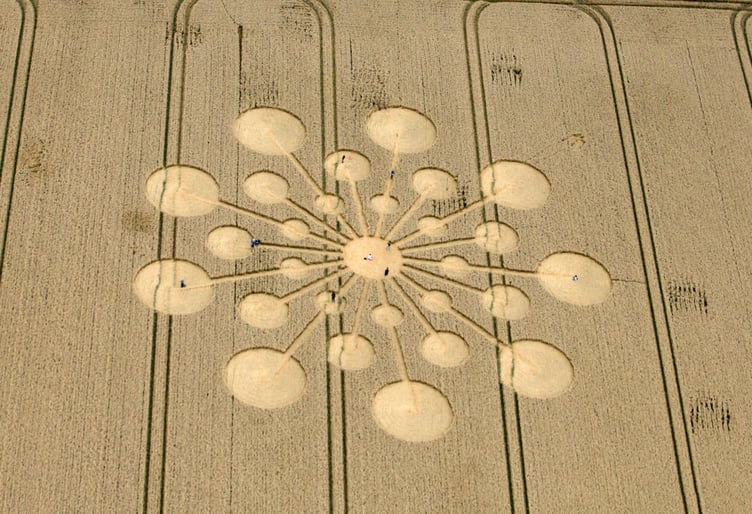It’s the fundamental question with crop circles. How are they made?
Whereas we have no definitive answer to this enigma as yet, there is increasing scientific evidence that when the ‘force’ hits the target, there is a huge electrical discharge measuring hundreds of thousands of volts per metre.
It lasts a nanosecond, which in the case of crops, softens the plants at the base, allowing them to fall.
This ‘force’, travelling upwards, breaks down the molecular structure inside the stems.
When the ‘force’ is too great it escapes through expulsion cavities in the nodes along the stems. The effect is similar to a baked potato exploding in a microwave oven when the energy is excessive.
It has also been found repeatedly that the seeds collected from inside a formation germinate faster and need less water than those gathered from outside the formation.
In addition, seeds taken from inside the circle showed a 40 per cent higher level than those taken from outside the circle.
Everyone has heard of crop circles – but what are they? The most striking features of these depressions in the crop are the neat swirling and flattening of the crop, and the sharp cut-off point between the flattened crop and the standing crop.
Not only have these events appeared in arable crops but in fields of potatoes and sugar cane, also in heather, sunflowers, rice paddies, snow and ice.
Later pentagrams, hexagrams, heptagons, octagons and triangles followed as the patterns increased in geometric complexity, taking us into 13-fold geometry in 2000 at Cherhill, near Calne, in Wiltshire, along with three dimensional Escher cubes, the forerunners of the cubic style.
There is no doubt that, in recent years, some have been created by hoaxers.
Several pilots during the Second World War reported flying over crop circles in the south of England. These were investigated by M15 fearing they might be codes left for the German pilots. That Wiltshire Crater!
Crop circles are clearly defined indentations in the crop. The flattened area has a sharp cut-off point where it meets the standing crop.
Just as the general view is the circles are (only) simple rings, so many people do not realise the geographical scale of the phenomenon.
Circles have been found on every continent on the planet and in 60 countries:
Africa. Botswana, Egypt, Kenya, Nigeria, South Africa, Yemen.
North America. Canada. USA.
South America. Argentina, Brazil, Chile, Colombia, Mexico, Uruguay.
Asia. Afghanistan, China, Cyprus, India, Iran, Israel, Kazakhstan, Malaysia, Russia, South Korea, Turkey, Ukraine.
Australia. New Zealand.
Central Europe. Austria, Belgium, Czech Republic, Italy, Luxembourg, Poland, Switzerland.
Western Europe. France. Germany, The Netherlands, Portugal. Macedonia.
Eastern Europe. Bulgaria, Croatia, Hungary, Latvia, Lithuania, Romania, Serbia, Slovakia, Slovenia.
Scandinavia. Denmark, Finland, Norway, Sweden.
Eire.
United Kingdom. England, Isle of Man, Isle of Wight, Scotland, Northern Ireland.
Moving back in time, we discover that in his book Hypomnemata Antiquaria, 17th-century antiquarian historian and philosopher John Aubrey (March 12, 1626-June 7, 1697 – after whom the Aubrey Stones at Stonehenge are named – was perplexed by green circles on the Downs in Wiltshire.
He wrote “I presume they are generated from the breathing out of a fertile subterraneous vapour.”
He further wrote that “every tobacco-taker knows that ’tis no strange thing for a circle of smoke to be whiff’d out of the bowle of the pipe; but ’tis donne by chance.”
The 1678 wood cut of the Mowing Devil is probably the most famous recorded crop circle event of early times. It shows a devil-like person cutting the crop with a scythe.
The story behind this wood cut tells us of a farmer having rejected the price charged by a harvester, stormed off saying he would rather let the Devil takes his oats.
That night he heard strange sounds and saw strange lights, only to find on entering his field the following morning that his crop had been cut in round circles, frightening him to such a degree that he took to his heels and fled.
The original report, now somewhat fragile, is in the British Library. Clearly this was of such importance that it was recorded and that record has passed down to us through the ages.
Bringing us closer to modern times is a report in July 1880 by John Capron (1829-1888), an amateur astronomer and highly-respected spectroscopist. He discovered the circles at the Hog’s Back near Guildford.
The Surrey Advertiser reported his findings at the time and many years later they were published in the respected scientific journal Nature in 1880 and reprinted in January 2000 issue of the Journal of Meteorology (ISSN 0307-5966: Volume 25, pp 20-21): “A case of genuine crop circles dating from July 1880, as published in Nature in the year 1880.”
I continue with my research into the temporary relief of Parkinson’s and Essential Tremor sufferers, led by an advanced clinical physiologist from the Devon and Exeter Hospital.
Much as we would love to find an easy answer to the origin of this phenomenon, currently it is beyond our present scientific or technical knowledge.
Whatever the answer, it is evident we are entering new and previously-unexplored areas of research and learning because of these beautiful and enigmatic creations in the landscape.
Not everything can be explained within the existing tried and tested laws and parameters of science.
As Einstein so aptly puts it: “There comes a time when the mind touches a higher plane of knowledge but can never prove how it got there.”





Comments
This article has no comments yet. Be the first to leave a comment.